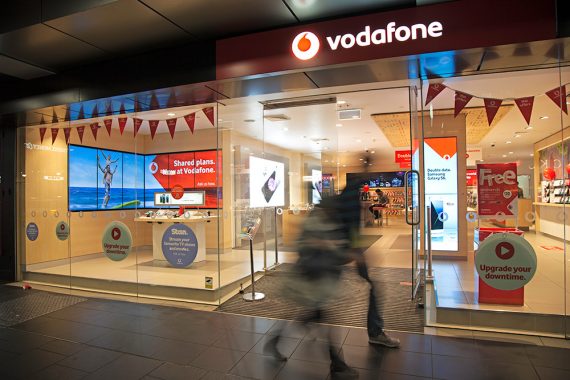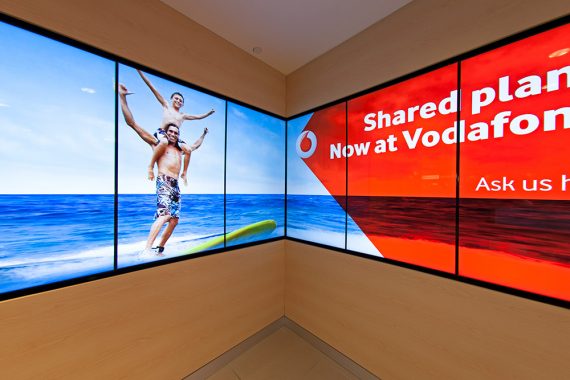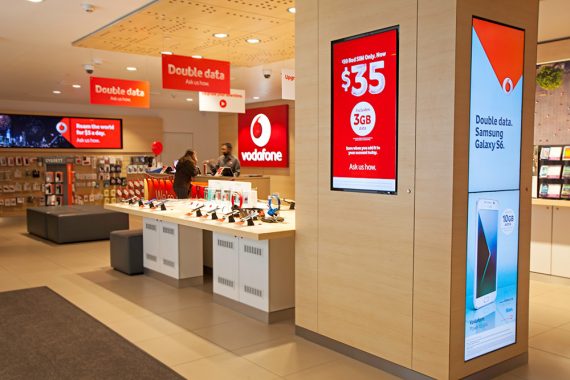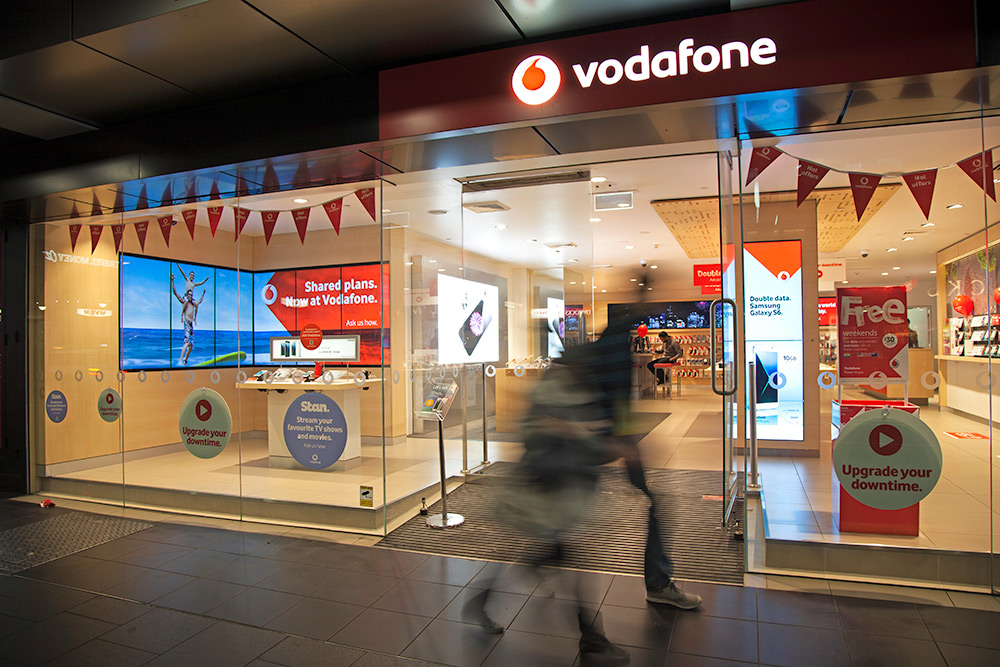
Vodafone has a futureproofed 900+ display digital signage network it can grow into.
Last year, Vodafone could only manage to execute one campaign a month across all its stores. This year, it can go with one per day if so desired.
Last year, Vodafone’s stores were stocked with the usual reams of printed advertising material and brochures. This year, that’s not necessary.
Last year, Vodafone was lumbering in its ability to respond to competitors’ offers in the cutthroat mobile phone market. This year it can respond with alacrity.
Last year, Vodafone had no granularity in its national marketing strategy. This year, it can drill down to a store level.
Last year, its in-store promotional materials were static. This year those campaigns are dynamic, engaging and interactive.
Last year, Vodafone didn’t have an integrated national digital signage network. This year, it does.
PHASE ONE
What you see on this spread is Phase 1 of a longer-term strategy. But already its worth is plain to see for all those involved. The primary purpose of Phase 1 (ie. moving to a digital signage solution) has the ability to deliver the latest and best value offers in real time and at a reduced ongoing cost.
Phase 1 is predominantly about the street facing signage with all the content scheduled by Vodafone HQ. The content is an extension of its current marketing and advertising campaigns which heavily features new handset launches, new plans and any specific offers to customers. By using the in-store screens in this way Vodafone creates a seamless integration of above- and below-the-line marketing, advertising and social media.
AHEAD IN THE CLOUD
The digital signage solution developed by Fujifilm Australia is something special. The cloud-based solution, which integrates Samsung commercial large format display (LFD) panels with built-in wi-fi, is powered by Signagelive for content distribution. [See elsewhere on this page for a full explanation.]
Fujifilm Australia Technology Manager Craig Rumsey explained, “Fujifilm Australia entirely designed and now supports Vodafone Australia’s digital signage networks as a complete end-to-end solution. The initial installation was into 100 stores in only 12 weeks. We have now installed a nationwide network of more than 900 displays with many more screens still to be installed.”
Vodafone might be testing the digital signage waters with the scope of the screen content but Fujifilm has built the network with the long term in mind — while Phase 1 concentrates on outward-facing, shop-window screens playing the same content, the potential for the system is far, far greater. Fujifilm has developed the system with Vodafone and its customers front of mind. This means as the system rolls into Phase 2 and beyond, Vodafone will be able to customise content per screen in store and prioritise screens with location and messaging. This is all now possible from Vodafone HQ and thanks to the ingenuity of Fujifilm’s tailor-made system, the only extra work required is the creation of individual playlists and schedules.
Already Fujifilm is testing what’s possible for future phases, exploring an interactive solution that allows Vodafone customers the ability to view and test Vodafone’s 4G coverage in store, in real time, using a touchscreen panel prior to signing up for a smartphone or mobile internet plan.

NO MEDIA PLAYER REQUIRED
By using Signagelive for content distribution the media is played directly through the Samsung commercial panels, thus not requiring an external media player. All that’s required in store is an internet connection. Each panel is an end point and licences to the Fujifilm solution and support are sold per panel. Once the panel is installed it connects to the Signagelive server via Vodafone’s 4G network and the content, previously uploaded by Vodafone, is immediately downloaded to the panel. The screens automatically check for new playlists and different playlists can be scheduled to run at any time.
ALL FROM HQ
Vodafone now has the complete freedom and flexibility of a centralised facility to run its countrywide digital signage network as all content is managed from Vodafone HQ, with the in-house team able to log in via a simple web portal. Content can be created, scheduled and managed on a local, regional or national basis, even down to ‘tagging’ individual panels depending on the requirements. This way Vodafone can run different messages on different panels based on their location in the store and tailor campaigns in a far more effective and targeted way than ever before. The system also allows campaigns to be run based on individual events such as sporting matches or seasons. The control over priorities and content is at Vodafone’s fingertips in real time.
There’s no doubt this Vodafone network has been future-proofed by Fujifilm.

SAMSUNG FLAT OUT AMAZING
Fujifilm and Vodafone have nothing but praise for the Samsung panels. The 900+ screens in the rollout drew from Samsung’s Professional Display series (specifically the DM65D, DM55D and DH55D models). Not only are they fast, robust and efficient but the image quality is exception and they look the part. “It’s hard to find other panels that match Samsung for quality and sharpness of image,” commented Fujifilm’s Craig Rumsey. As a result Fujifilm has several other significant digital signage projects in the pipeline all of which will use the same Samsung flat panel displays.
TECH TALK: THE SAMSUNG WAY
Historically, the deployment of a digital sign requires a screen, a separate media player to store the media content, and some kind of content management system to tell the media player what to play and when to play it.
The Vodafone deployment demonstrates some of the benefits of doing things a little differently: the Samsung Way.
The first acronym to get your head around is SSSP or Samsung Smart Signage Platform. SSSP replaces the media player with an integrated processor that can store the media and run an open source system platform. SSSP is included on Samsung’s commercial-grade panels, including the DME, UED and DHE series.
Samsung’s new 2nd Generation SSSP offers significantly improved performance thanks to a 1GHz quad-core CPU and 1.5GB double data rate (DDR3) dual 48-bit memory. One measure of how powerful the processor is, is the picture-in-picture size you can run. The second generation SSSP-enabled displays offer a PIP size over 50 percent of the display.
That’s the hardware, and Samsung has considered the software as well.
Traditionally, a third-party provider takes care of the content management. The 2nd Generation SSSP is now compatible with third-party software, or in the case of the Vodafone job you can use Signagelive — Samsung’s recommended cloud-based signage management software. The Samsung Smart Signage Platform, powered by Signagelive, has provided Vodafone with a centralised facility to run and manage a countrywide digital signage network (948 screens and counting).
“This is our biggest Samsung SSSP installation by far,” comments Jason Cremins, CEO and owner of Signagelive. “By integrating our ‘system on a chip’ software into the FujiVision brand, Fujifilm has eliminated the need for onsite media players and has been able to cost effectively roll out a digital signage network that can be managed locally, centrally or remotely using any device.”
Fujifilm: www.Fujifilm.com.au
Samsung: www.samsung/au/business or business.partner@samsung.com
Signagelive: www.signagelive.com

